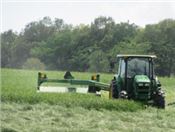Baling Between May 10 And May 15 In Southwest Missouri Leads To Highest Quality Hay

Cut early for quality hay.
MT. VERNON, MO.
The month of May is nearly here and that means it is time for producers to prepare to make the highest quality hay harvest in 2019.
“I know the weather can mess up your plans with rain, cool weather and not as much sun as you’d like for putting up dry hay. The adoption of high moisture haylage though can help you have a wider window for quality hay production,” said Eldon Cole, livestock specialist with University of Missouri Extension.
For years, MU Extension specialists have advised those who put up fescue hay that it should be baled in the boot to early head stage of growth.
“By the calendar in this part of Missouri, you can almost set your clock on that ideal time being from May 10 to 15,” said Cole.
With the shortage of hay this area experienced in 2018, Cole thinks farmers will try to delay hay harvest until later in May or early June. Their logic may be that they will up their empty barns or bale yards. Unfortunately, the TDN (total digestible nutrients) level goes down drastically as the forage being raising matures.
“As the ratio of stems to leaves increases hay, quality of hay goes down,” said Cole.
Fescue especially deteriorates with maturity as toxin levels also rise (especially with the hot Kentucky 31 variety).
“You may not be baling hay but intend to use fescue for pasture. If that is the case, clipping seed heads early will improve grazing. Clipping also gives legumes a better chance of surviving, and that should improve the grazing quality later in the summer,” said Cole.
Quality hay may be cut at the proper stage, but the quality will be compromised if producers get in a hurry and bale it before it is adequately dried.
The ideal moisture range for small square bales is 18 to 22 percent. Large round bales should be drier at only 14 to 18 percent moisture. Large rectangular bales need to be the driest at 12 to 16 percent. Many farmers now use moisture meters to help them keep in the proper moisture range. This practice will result in less moldiness and loss of nutrients and palatability in the hay.
“To validate the quality of hay consider having a lab test now on random lots of hay for at least TDN, protein neutral detergent fiber and relative forage quality (RFQ),” said Cole.
TESTING AND CONTEST
The lab some have used in the past at Golden City has relocated to 3068 Highway 37 just south of Monett. You may contact them at 417-553-8510 or call your nearest University of Missouri Extension Center to learn proper sampling practices for hay and haylage.
“In addition to testing your forage for your own feeding, consider making an entry in the Ozark Empire Fair Hay Show. Details on that are available at the Extension Centers in each county. Deadline for entries is July 20,” said Cole. ∆